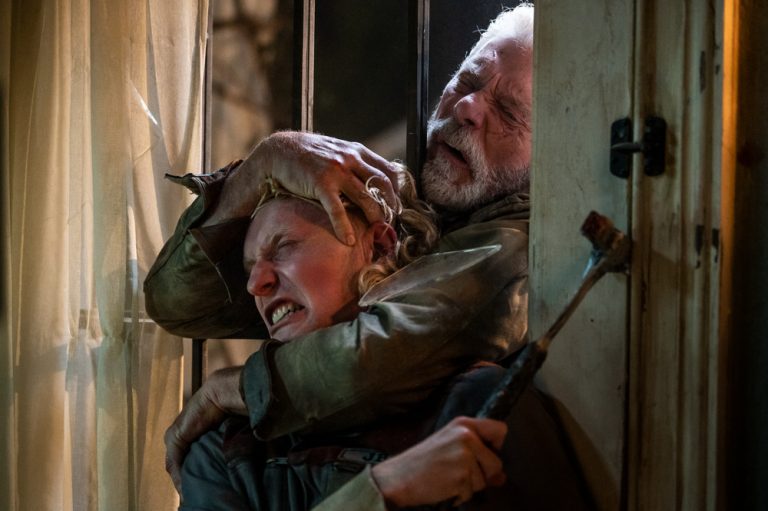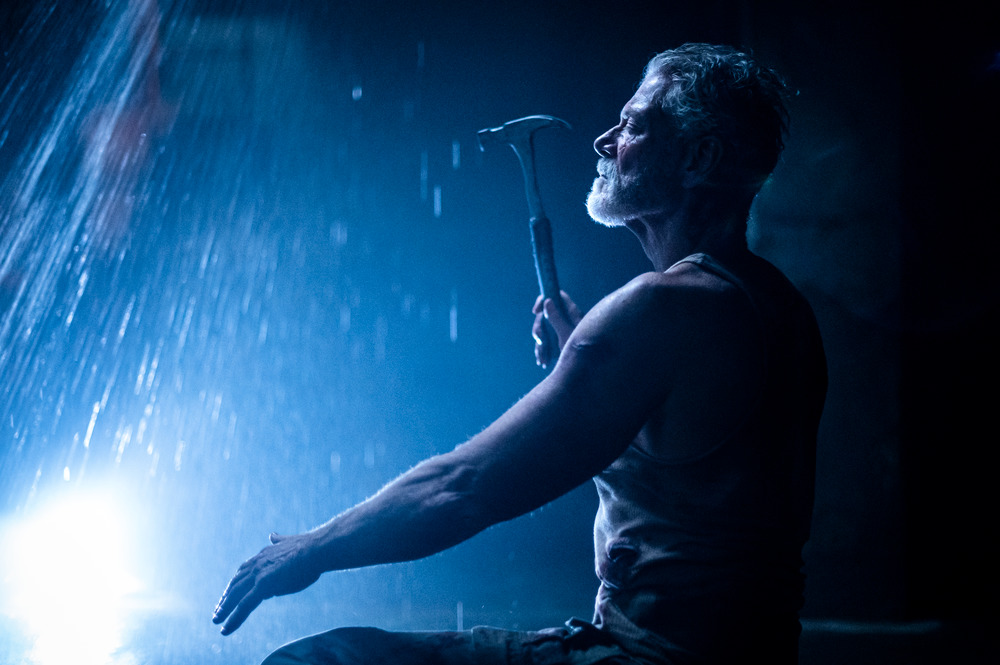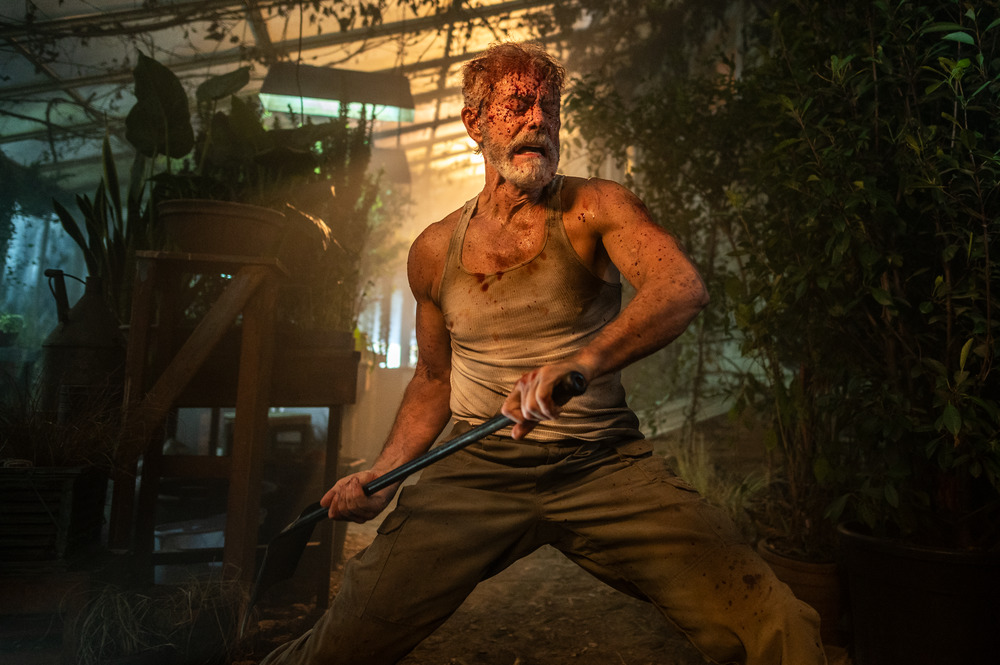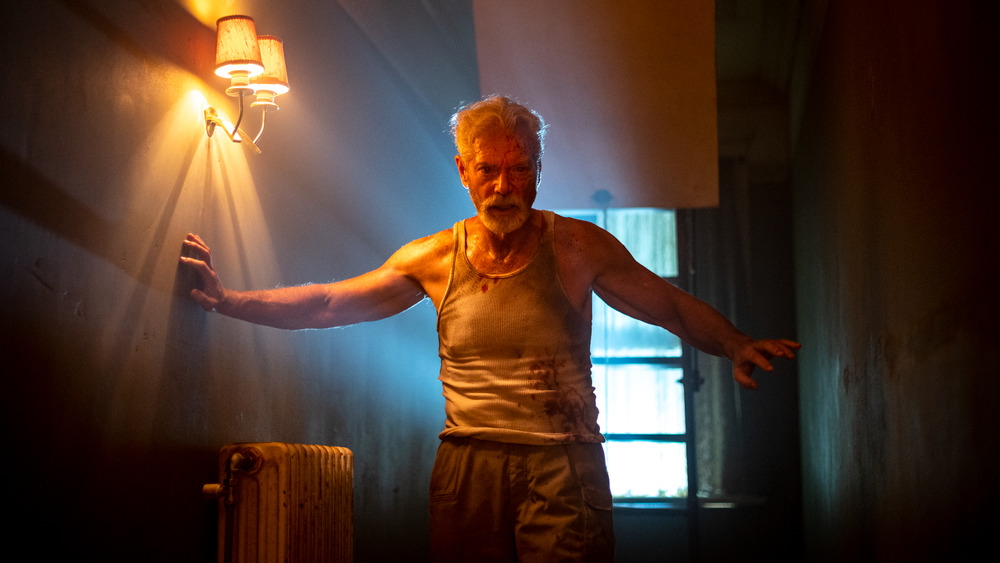
Don’t Breathe 2
Synopsis : The sequel is set in 8 years after the initial deadly home invasion, where a blind man, Norman Nordstrom (Stephen Lang) lives in quiet solace until his past sins catch up to him.

Interview with Writer/Director Rodo Sayagues and Writer/Producer Fede Alvarez
Q : I wanted to ask, how did you direct Madelyn Grace, who plays Phoenix? How did you direct her through some of those more violent scenes?
Rodo Sayagues: She does 95% of the job. It’s amazing, because she’s eleven but she’s been acting since she is five or something. It’s cool. And then she started taking acting lessons so she’s very much in tune with the process. It really amazed me how professional she is. And of course she’s there with a tutor, with her mother, and everybody’s helping, and we make the best possible environment for her to do this and take it as a game.
She’s playing. She’s not working. Of course, she’s just playing, the hours are shorter and our job is just to make it feel as a game that she’s just playing. Even when the final product in this movie looks intense and violent, when you’re shooting, it’s not like that at all. It’s a game. There are scenes with her performing underwater, which were the ones that I thought were going to be more challenging, and she was loving it. She didn’t want to get done with that scene and that day. She just kept wanting to go and go and do it again. She said, can we shoot that whole thing again tomorrow? I said no, I’m sorry, that’s not how it works. But I think the key is make it feel like it is a game.
Fede Alvarez: You have a shot of them witnessing something, going oh my god, and there’s nothing in front of them. Not what you see that’s in front of them. So there’s also a lot of that. They’re usually kids in this movie and they’re not witnessing what the audience is when it comes to horror and gore. It’s just them playing.
Rodo Sayagues: In terms of the dramatic performance, she just killed it everyday. She’s just a kid and she’s having fun talking to everyone on set and then when it comes to go to work and we call action, she transforms in a split second and she just does everything that needs to be done in a such a talented and deep and connected way. It’s amazing. It blew me away.
Q : The last scene from the original film that the girl and sister walking away on the main station, but the blind man didn’t go after them even though they’ve got all this money. So what inspired you for this other story that you did with the Sequel?
Fede Alvarez: I think we’ve been lucky enough at least with the couple horror movies we’ve made. They did good enough and people liked it enough to grant us a sequel. The first time around with The Evil Dead, we realized that the place it was going to go to was going to be quite generic. There’s a natural momentum to a lot of these movies that the sequel doesn’t take a lot of effort to figure it out. Filmmakers in general are guilty of the sin of just going the easy way and giving the audience exactly the same but bigger and that’s it. And we were really trying hard not to do that it and to come up with a concept that was not what you expected.
So even if that’s what you read from the end of it, while it might have been an idea at some point, we actually shot a version of that and it could have been that he was after them, but then we realized it was going to be silly, somehow. But still, I think this story was going to be just a fresher take on a part two. It doesn’t happen a lot of times. A lot of times the part twos are not really good. So we were really trying to put us in a place where not only could we be faithful to the spirit of the first one so people feel they’re in the same universe but that could be also a standalone story. If you change the character, this could be a standalone story that starts from scratch. So we felt that that was more exciting for us as filmmakers, to go through the challenges of creating a full story.
As writers, we thought that that was a bigger challenge. And that’s what we look for all the time. When you do this, you want to do something that really requires all your abilities and you’re topped. This is the best we can do. We cannot do better, unfortunately. This is the best we could do when it comes to storytelling. We really try hard, we try hard to not take that the easy way. So I think that that story might have been, well she’s at home. I think any one of you could pitch me that version you were talking about in two seconds. She’s at home. There’s some noise outside. Who is it? Is it him? Psychological thriller a little bit, maybe he is, maybe he isn’t. This story required a lot more crafting, so that’s why I think we didn’t go that way. We just didn’t find it that interesting.
Rodo Sayagues: Also, if you remember, in the first movie, they kind of make a deal. The blind man says take the money, and I know since you’re taking the money, you’re not going to say anything about what I have done. So you get away with it and I get away with it as well. It’s kind of like a shared secret. It’s better for both of us to never speak about this, because you’ve got a lot to lose and I’ve got a lot to lose, so that’s the deal. So it would be weird for this guy to, right away, be like, you know what, I’m going to go find the girl. It would be risky for him as well.
Fede Alvarez: He’s done a lot of horrible things, but it seems like he will have a code with that, maybe. Even in that movie, he lies when he says, I won’t go and then he goes after them and kills Alex, but I think he honors that thing, he makes a deal with them. The ominous feeling of that last shot for us was, there goes her soul. Because now she’s taken the money and she could go to the cops and give back the money and tell them, look, this guy did all these horrible things and had a girl in a cell, just go find him. You’ve got to give closure to Cindy’s parents and she chose to take the money. This is not a happy ending because she didn’t take the honorable route.

Q: I have a question concerning the image that we see of the USA right at the very beginning of Don’t Breathe. We see these streets of abandoned buildings. It’s a very futile imagine of this bleak atmosphere. In Don’t Breathe 2, I almost have the feeling that it’s bleaker than it is given the fact of what people do to make a living. So my question is, maybe this has me over interpreting, but in what way are these films, both of them, meant as allegories to the state of the US and perhaps to the state of the world?
Fede Alvarez: Yeah. You’re definitely reading the right thing. For us, we always say that the world of Don’t Breathe is not the real world. It’s almost post-apocalyptic. That’s why we chose Detroit in a way because the worst parts of Detroit really represent that decay. And in a way, it might even represent the future of many other areas, that industry, the car industry at that point was a thing and it fed of all that town in America. So there’s definitely some of that vision in us and we think it shows that decay. We always knew the second one was going to be even deeper into the woods because he moves.
This is all based on reality. What you saw in the first movie, we didn’t change any of that landscape. That’s exactly how that street looks. The house where the story happens is exactly that way. If you go to Google Street View, you’ll find exactly that house, looking great in the street that looks terrible. We didn’t manipulate it. So as far as allegory goes, it was pretty realistic. It looks the way it looks. We didn’t exaggerate it. And the same in this one. The landscape, there’s areas that now are being taken back by nature, but also the communities are doing a good job of keeping it clean and cutting the grass and all that. This takes part even outside, but I think the character of Norman, who’s really isolated even more from society, he’s pushing away out of the urban area to the more outer rims of Detroit. But there’s definitely that, not just in America but in the world. It’s not that we’re pessimists. I think we’re just really trying to show a face of the country that is not shown in movies a lot.
Rodo Sayagues: For all of the characters in both movies, they are in a way some type of outcasts whom the system has failed. They’re living outside of the system and they have to come up with their own rules and laws. Come up with their own ways to be able to survive in this environment. It is very much like that, and we think that represents the dimension of reality for a lot of people, not only in the US but in the whole world, that they feel marginalized from a certain system. It’s our point of view on a part of reality. So yes, you’re right. It works as an allegory in that regard.
Q: Besides the girl, there are not a lot of intriguing characters. But the one character that I love is the sound design. Could you talk about that?
Rodo Sayagues: Sound design, because of the nature of the story, sound right away becomes a very important narrative element as well. That’s one of the reasons why it’s very important to experience this movie in a movie theater, where you get to enjoy the full sound experience. It’s very hard to replicate at home. It’s of massive importance. At many points in the story, it’s just sound telling you what’s happening. And that of course brought into the team very talented people because they liked the opportunity to display their skills in a movie like this where sound is going to be in the front seat. So we were lucky to work with very talented people that did an amazing job. It’s unique to this movie how much the sound is prevalent and the importance it has.
Fede Alvarez: It is part of the franchise. There’s so little dialogue. As Spanish-speaking people on the first movie, we thought, how can we get away with writing a movie when we barely speak the language. So we figured out, let’s have no dialogue in it. We have like five lines in the first movie. The less dialogue, the more silence there is, the more silence is part of the story. The more chance you have to become really attuned with silence. You start hearing the fridge, you start hearing the loose steps, so it becomes a sensorial experience that we start with the first film. And Rodo took it to a completely different level in this one because there’s a lot more. It’s way fancier. I was so impressed with all the things that are done in this one when it comes to that. You need to tell stories that allow for that, and no doubt that, when it comes to the theatrical experience, that’s why you want to really try to get an Atmos theater that has the best sound so you can have a very unique experience.

Q: How was it passing the baton, Fede, to your colleague, who is now a director. And how do you feel about being part of the Latin-American community that it right now in the industry working and making a lot of creative projects?
Fede Alvarez: Passing the baton, I think it was easy because he did a great job. When they decided that I wasn’t going to direct it, I felt like, who can do it, and we didn’t want to bring any director from outside that didn’t know the character. I think the transition for writers into directors is usually a really smooth one, better than from other areas sometimes because a good director has to be a good storyteller above all things. People sometimes think too much about the technical aspects, but you have to have a great DP on set, you have to have a great team of heads of departments that will help you with the technical.
The hardest part is to keep your finger on the pulse of the story as you’re shooting every scene completely out of order and you know what’s the story you’re building. And that’s why you have to be a great storyteller and this guy here is one of the best storytellers I know. That’s why I trusted him with the movie. When the thing was going at some point, we were like, what are we doing? He’s going to make a big movie and has never directed a movie, but then as soon as we start seeing the footage and seeing the story, we were super happy with it. I couldn’t be more at a proud of the movie he made. And then on the Latin side, it’s a lot of responsibility.
There’s not enough of us here. I tell you, not enough. There’s a lot of people working in different departments but, as directors and writers, sometimes when we’re trying to find a Latin-America writer to collaborate with us, it’s not easy. It’s not that the industry hasn’t opened itself, I think the industry has opened, it’s just that the countries in Latin America haven’t developed enough their cinema to develop people that will be ready to come. It’s a little of both things.
You need both sides. You need this place to be more open, but also, our homes, Uruguay, and the rest of Latin America, to create more chances at home to develop their talents so they can start making the transition and cross over to this place. Not that they have to. It’s not a value where this is better than anything else. But I think we really hope there was more. There is, but there’s not enough and there’s just such a massive Latin-American audience inside the United States, Spanish-speaking audience in the United States. It would be great that there’s more voices, more Latin voices to write stories and talk to that audience.
Q : I want to ask about the technical side and the camera angle. The first time the burglar gets in the house, there’s a really cool shot with Phoenix running down the house. They shot it in one shot. How did you set up the camera for this film to kick it up a notch from the first film? What kind of preparation did you do?
Rodo Sayagues: When you go out and make a movie, you have to put a lot of energy into first of all, creating a certain world. That’s one of the biggest challenges for a director. You need to create a world, how it looks, how it feels, of course, the cast, the camera language. You have to do all of that and that takes a lot of time and a lot of energy. When doing a movie like this, there was a lot of work that was already done. The camera language, the feel, the looks. Fede had created with the first movie already, so that job done is already done.
Now we have a lot more time to figure out other stuff, so we can devote a lot of time to figuring stuff out like that. The first movie, there was a long shot that lasted for maybe two or three minutes that established the whole house and all the other elements that we’re going to play out later. Let’s try to expand on that. I think we devoted weeks to come up and create that shot that you’re talking about that lasts five and a half to six minutes. It has actors and a lot of action in it. So I think that takes time, time and energy, dedication. I think we were only able to do that because all the rest have been taken care of by Fede it before.
Fede Alvarez: I would say by the both of us. We crafted the story in the first movie together and all of those shots are in the script. The script says, we see this, we see that, and in this one, it was already in the script that we are going to travel through this scene in one single and uninterrupted shot. Sometimes, things come out, but this time at least, it was already planned and like everything, we had created it together.
Rodo Sayagues: But it is challenging in this very restricted space. It’s a house, there’s hallways everywhere. It’s always challenging. In terms of the technical aspects of it, we could talk for hours and days but, yeah, it is very challenging. It’s hard to do but the team that we had, our DP Pedro Luque, who did the first movie with Fede as well, loves doing these kinds of things. So I had the best team possible to be able to achieve something.
Fede Alvarez: A piece of trivia for those who don’t know. Pedro did in Uruguay a movie called The Silent House that was a Uruguayan movie that was entirely a single shot horror movie, and then they made an American remake, yes, with the Olsen girl from WandaVision. The same DP that was able to pull out an entire movie like that. I’m sure it was simpler in some ways, a little more complicated in others, but also, he brings a lot of tension. There’s no doubt that, when done well, it brings an incredible amount of tension to a scene when there’s no cuts.

Q : Some of the final sequences reminded me of Star Wars, such as the Blind Man’s line, I am no father, and his dying words, you already have, are Darth Vader’s famous last words. And the last shot of the girl replying with her new name is kind of like how The Rise of Skywalker ends. Would you say that this film is a homage to Star Wars?
Fede Alvarez: Well, Star Wars is a homage to many other things as well. At the end of the day, you’re talking the hero myth. Joseph Campbell. If you go back, you can trace it to thousands and thousands of years.
Rodo Sayagues: Every genre movie is inspired by Star Wars.
Fede Alvarez: Unless you find the one director that has not seen the Star Wars movies, particularly Empire Strikes Back, that goes like, yeah, that one I’ve heard of, but I have not seen it. The day you find that director, he will be the only one not influenced by that movie. The funny thing is, we didn’t know. We wrote the dialogue, and then Rodo called me one day and was like, hey, I just realized there’s an issue. The dialogue at the end is exactly what Luke says to Darth Vader, and I was like, really? What should do? Let’s leave it and let smart people figure it out.
Rodo Sayagues: Not only that, but the whole configuration of the final scene, you can compare that to that scene with the Emperor, Darth Vader and Luke.
Fede Alvarez: The red smoke also because it’s like when Han Solo gets inside the Carbonite.
Rodo Sayagues: It’s all over the place. It makes such an imprint in your subconscious that it’s inevitable that it comes out. In all honesty, it was not conscious at all. We just played out that and then we came up those lines, and then we thought, wait a minute, there’s a lot of Star Wars here, that final climax with a father figure, mother figure, this and this and that. I don’t want to spoil anything. But you know what I mean. It just comes out in a very organic and natural way and we love to see that happening.
Fede Alvarez: But there’s going to be people in the audience, the hardcore fans, they’re going to go, what? When the dialogue happens.
Q : In the first film, the old man’s abnormalities suppress any feelings of sympathy the audience could have had for the character. What was the purpose in creating such a character, and how did you want to build on that in the sequel?
Fede Alvarez: The first movie is all about this guy that does horrendous things, but justifies every single one of them. That’s why it’s a compelling character. Because every time you judge him, he goes, ah, yeah, wait, but listen, this is why I’m doing it, and he can give you some very strong arguments for why he’s doing whatever he’s doing. In his head, he’s convinced. He’s really good at arguing why he’s doing it. He’s clearly doing unspeakable things but he’s completely defending himself.
So we thought it would be interesting to tell part two where he will have to get out of there and come to terms with who he is and what he’s done. And accept that. Because what he feared the most in the first movie is to be the villain. That’s what he fears the most. He’s convinced he’s not. He’s convinced he’s a hero in the first movie. The thing this character fears the most is to have to face the reality of what he’s done. And that was really what the story is about. Without spoiling anything, let’s hope that at the end of the movie, he managed to see who he truly is.
Here’s the trailer of the film.

